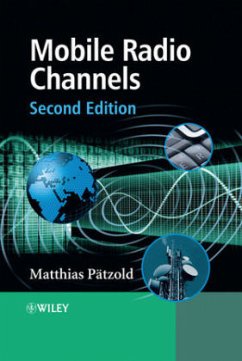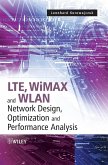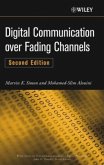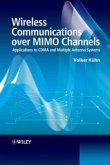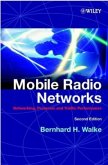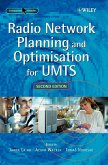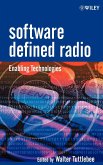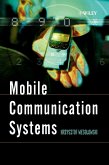Matthias Paetzold
Mobile Radio Channels
Matthias Paetzold
Mobile Radio Channels
- Gebundenes Buch
- Merkliste
- Auf die Merkliste
- Bewerten Bewerten
- Teilen
- Produkt teilen
- Produkterinnerung
- Produkterinnerung
Providing a comprehensive overview of the modelling, analysis and simulation of mobile radio channels, this book gives a detailed understanding of fundamental issues and examines state-of-the-art techniques in mobile radio channel modelling. It analyses several mobile fading channels, including terrestrial and satellite flat-fading channels, various types of wideband channels and advanced MIMO channels, providing a fundamental understanding of the issues currently being investigated in the field.
Important classes of narrowband, wideband, and space-time wireless channels are explored in…mehr
Andere Kunden interessierten sich auch für
![Lte, Wimax and Wlan Network Design, Optimization and Performance Analysis Lte, Wimax and Wlan Network Design, Optimization and Performance Analysis]() Leonhard Korowajczuk (Hrsg.)Lte, Wimax and Wlan Network Design, Optimization and Performance Analysis204,99 €
Leonhard Korowajczuk (Hrsg.)Lte, Wimax and Wlan Network Design, Optimization and Performance Analysis204,99 €![Digital Communication Over Fading Channels Digital Communication Over Fading Channels]() Marvin K. SimonDigital Communication Over Fading Channels325,99 €
Marvin K. SimonDigital Communication Over Fading Channels325,99 €![Wireless Communications Over MIMO Channels Wireless Communications Over MIMO Channels]() Volker KuhnWireless Communications Over MIMO Channels164,99 €
Volker KuhnWireless Communications Over MIMO Channels164,99 €![Mobile Radio Networks Mobile Radio Networks]() Bernhard H. WalkeMobile Radio Networks331,99 €
Bernhard H. WalkeMobile Radio Networks331,99 €![Radio Network Planning and Optimisation for Umts Radio Network Planning and Optimisation for Umts]() Jaana Laiho / Achim Wacker / Tomás Novosad (eds.)Radio Network Planning and Optimisation for Umts159,99 €
Jaana Laiho / Achim Wacker / Tomás Novosad (eds.)Radio Network Planning and Optimisation for Umts159,99 €![Software Defined Radio Software Defined Radio]() Walter Tuttlebee (Hrsg.)Software Defined Radio229,99 €
Walter Tuttlebee (Hrsg.)Software Defined Radio229,99 €![Mobile Communication Systems Mobile Communication Systems]() Krzysztof WesolowskiMobile Communication Systems164,99 €
Krzysztof WesolowskiMobile Communication Systems164,99 €-
-
-
Providing a comprehensive overview of the modelling, analysis and simulation of mobile radio channels, this book gives a detailed understanding of fundamental issues and examines state-of-the-art techniques in mobile radio channel modelling. It analyses several mobile fading channels, including terrestrial and satellite flat-fading channels, various types of wideband channels and advanced MIMO channels, providing a fundamental understanding of the issues currently being investigated in the field.
Important classes of narrowband, wideband, and space-time wireless channels are explored in detail with descriptions of efficient simulation methods for mobile radio channels being central. Strong emphasis is placed on the detailed origin of the presented channel models and a high degree of mathematical unity is conveyed. Using the described channel models, the reader can evaluate the performance of wireless communication systems under propagation conditions which are typical for multipath channels in various environments.
Introduces the fundamentals of stochastic and deterministic channel models
Explores the modelling and simulation of both wideband and narrowband mobile radio channels as well as several classes of MIMO channels
Describes general concepts including geometrical, reference and simulation models
Discusses several methods for the modelling of given Doppler, delay, and angular profiles
Elaborates on methods for the design, analysis, and realisation of efficient channel simulators
Examines techniques for the development of fast channel simulators
Provides links for downloading MATLAB(r), programs enabling the simulation and analysis of the mobile fading channels models presented, on the companion website (www.wiley.com/go/paetzold)
Hinweis: Dieser Artikel kann nur an eine deutsche Lieferadresse ausgeliefert werden.
Important classes of narrowband, wideband, and space-time wireless channels are explored in detail with descriptions of efficient simulation methods for mobile radio channels being central. Strong emphasis is placed on the detailed origin of the presented channel models and a high degree of mathematical unity is conveyed. Using the described channel models, the reader can evaluate the performance of wireless communication systems under propagation conditions which are typical for multipath channels in various environments.
Introduces the fundamentals of stochastic and deterministic channel models
Explores the modelling and simulation of both wideband and narrowband mobile radio channels as well as several classes of MIMO channels
Describes general concepts including geometrical, reference and simulation models
Discusses several methods for the modelling of given Doppler, delay, and angular profiles
Elaborates on methods for the design, analysis, and realisation of efficient channel simulators
Examines techniques for the development of fast channel simulators
Provides links for downloading MATLAB(r), programs enabling the simulation and analysis of the mobile fading channels models presented, on the companion website (www.wiley.com/go/paetzold)
Hinweis: Dieser Artikel kann nur an eine deutsche Lieferadresse ausgeliefert werden.
Produktdetails
- Produktdetails
- Verlag: Wiley & Sons
- 2. Aufl.
- Seitenzahl: 616
- Erscheinungstermin: 7. November 2011
- Englisch
- Abmessung: 257mm x 177mm x 33mm
- Gewicht: 1060g
- ISBN-13: 9780470517475
- ISBN-10: 0470517476
- Artikelnr.: 27556537
- Herstellerkennzeichnung
- Libri GmbH
- Europaallee 1
- 36244 Bad Hersfeld
- gpsr@libri.de
- Verlag: Wiley & Sons
- 2. Aufl.
- Seitenzahl: 616
- Erscheinungstermin: 7. November 2011
- Englisch
- Abmessung: 257mm x 177mm x 33mm
- Gewicht: 1060g
- ISBN-13: 9780470517475
- ISBN-10: 0470517476
- Artikelnr.: 27556537
- Herstellerkennzeichnung
- Libri GmbH
- Europaallee 1
- 36244 Bad Hersfeld
- gpsr@libri.de
Matthias Pätzold was born in Engelsbach, Germany, in 1958. He received the Dipl.-Ing. and Dr.-Ing. degrees in electrical engineering from Ruhr-University Bochum, Bochum, Germany, in 1985 and 1989, respectively, and the habil. degree in communications engineering from the Technical University of Hamburg-Harburg, Hamburg, Germany, in 1998. From 1990 to 1992, he was with ANT Nachrichtentechnik GmbH, Backnang, Germany, where he was engaged in digital satellite communications. From 1992 to 2001, he was with the Department of Digital Networks at the Technical University Hamburg-Harburg. Since 2001, he has been a full professor of mobile communications with the University of Agder, Grimstad, Norway. He is author of the books "Mobile Radio Channels - Modelling, Analysis, and Simulation" (in German) (Wiesbaden, Germany: Vieweg, 1999) and "Mobile Fading Channels" (John Wiley & Sons, 2002) and "Mobile Radio Channels, 2nd Edition" (John Wiley & Sons, 2011). His current research interests include mobile radio communications, especially multipath fading channel modelling, multiple-input multiple-output (MIMO) systems, channel parameter estimation, and coded-modulation techniques for fading channels.
Preface to the Second Edition xi
List of Acronyms xv
List of Symbols xix
1 Introduction 1
1.1 The Evolution of Mobile Radio Systems 1
1.2 Basic Knowledge of Mobile Radio Channels 8
1.3 Structure of this Book 12
2 Random Variables, Stochastic Processes, and Deterministic Signals 17
2.1 Random Variables 17
2.1.1 Basic Definitions of Probability Theory 17
2.1.2 Important Probability Density Functions 24
2.1.3 Functions of Random Variables 35
2.2 Stochastic Processes 37
2.2.1 Stationary Processes 40
2.2.2 Ergodic Processes 42
2.2.3 Level-Crossing Rate and Average Duration of Fades 43
2.2.4 Linear Systems with Stochastic Inputs 45
2.3 Deterministic Signals 48
2.3.1 Deterministic Continuous-Time Signals 48
2.3.2 Deterministic Discrete-Time Signals 50
2.4 Further Reading 52
Appendix 2.A Derivation of Rice's General Formula for the Level-Crossing
Rate 52
3 Rayleigh and Rice Channels 55
3.1 System Theoretical Description of Multipath Channels 56
3.2 Formal Description of Rayleigh and Rice Channels 61
3.3 Elementary Properties of Rayleigh and Rice Channels 62
3.3.1 Autocorrelation Function and Spectrum of the Complex Envelope 62
3.3.2 Autocorrelation Function and Spectrum of the Envelope 65
3.3.3 Autocorrelation Function and Spectrum of the Squared Envelope 67
3.4 Statistical Properties of Rayleigh and Rice Channels 69
3.4.1 Probability Density Function of the Envelope and the Phase 70
3.4.2 Probability Density Function of the Squared Envelope 72
3.4.3 Level-Crossing Rate and Average Duration of Fades 73
3.4.4 The Statistics of the Fading Intervals of Rayleigh Channels 77
3.5 Further Reading 84
Appendix 3.A Derivation of the Jakes Power Spectral Density and the
Corresponding Autocorrelation Function 84
Appendix 3.B Derivation of the Autocorrelation Function of the Envelope 88
Appendix 3.C Derivation of the Autocovariance Spectrum of the Envelope
Under
Isotropic Scattering Conditions 90
Appendix 3.D Derivation of the Level-Crossing Rate of Rice Processes with
Different Spectral Shapes of the Underlying Gaussian Random
Processes 91
4 Introduction to Sum-of-Sinusoids Channel Models 95
4.1 Principle of Deterministic Channel Modelling 96
4.2 Elementary Properties of Deterministic Sum-of-Sinusoids Processes 102
4.3 Statistical Properties of Deterministic Sum-of-Sinusoids Processes 107
4.3.1 Probability Density Function of the Envelope and the Phase 108
4.3.2 Level-Crossing Rate and Average Duration of Fades 115
4.3.3 Statistics of the Fading Intervals at Low Signal Levels 120
4.3.4 Stationarity and Ergodicity of Sum-of-Sinusoids Processes 122
4.4 Classes of Sum-of-Sinusoids Processes 123
4.5 Basics of Sum-of-Cisoids Channel Models 126
4.5.1 Elementary Properties of Stochastic Sum-of-Cisoids Processes 127
4.5.2 Probability Density Function of the Envelope and Phase 129
4.6 Criteria for the Performance Evaluation 135
4.7 Further Reading 135
Appendix 4.A Derivation of the Autocorrelation Function of the Squared
Envelope
of Complex Deterministic Gaussian Processes 136
Appendix 4.B Derivation of the Exact Solution of the Level-Crossing Rate
and the
Average Duration of Fades of Deterministic Rice Processes 137
5 Parametrization of Sum-of-Sinusoids Channel Models 149
5.1 Methods for Computing the Doppler Frequencies and Gains 151
5.1.1 Method of Equal Distances (MED) 151
5.1.2 Mean-Square-Error Method (MSEM) 157
5.1.3 Method of Equal Areas (MEA) 162
5.1.4 Monte Carlo Method (MCM) 170
5.1.5 Jakes Method (JM) 178
5.1.6 Lp-Norm Method (LPNM) 189
5.1.7 Method of Exact Doppler Spread (MEDS) 201
5.1.8 Randomized Method of Exact Doppler Spread (RMEDS) 205
5.1.9 Method of Exact Doppler Spread with Set Partitioning (MEDS-SP) 207
5.2 Methods for Computing the Phases 212
5.3 Fading Intervals of Deterministic Rayleigh Processes 214
5.4 Parametrization of Sum-of-Cisoids Channel Models 222
5.4.1 Problem Description 222
5.4.2 Extended Method of Exact Doppler Spread (EMEDS) 222
5.4.3 Lp-Norm Method (LPNM) 224
5.4.4 Generalized Method of Equal Areas (GMEA) 225
5.4.5 Performance Analysis 228
5.5 Concluding Remarks and Further Reading 234
Appendix 5.A Analysis of the Relative Model Error by Using the Monte Carlo
Method 236
Appendix 5.B Proof of the Convergence of the Sample Mean Autocorrelation
Function by Using the MEDS-SP 238
Appendix 5.C Proof of the Condition for Uncorrelated Inphase and Quadrature
Components of SOC Processes 239
6 Frequency-Nonselective Channel Models 241
6.1 The Extended Suzuki Process of Type I 243
6.1.1 Modelling and Analysis of Short-Term Fading 243
6.1.2 Modelling and Analysis of Long-Term Fading 254
6.1.3 The Stochastic Extended Suzuki Process of Type I 257
6.1.4 The Deterministic Extended Suzuki Process of Type I 262
6.1.5 Applications and Simulation Results 265
6.2 The Extended Suzuki Process of Type II 268
6.2.1 Modelling and Analysis of Short-Term Fading 269
6.2.2 The Stochastic Extended Suzuki Process of Type II 279
6.2.3 The Deterministic Extended Suzuki Process of Type II 283
6.2.4 Applications and Simulation Results 287
6.3 The Generalized Rice Process 290
6.3.1 The Stochastic Generalized Rice Process 291
6.3.2 The Deterministic Generalized Rice Process 295
6.3.3 Applications and Simulation Results 298
6.4 The Modified Loo Model 300
6.4.1 The Stochastic Modified Loo Model 300
6.4.2 The Deterministic Modified Loo Model 311
6.4.3 Applications and Simulation Results 317
6.5 Modelling of Nonstationary Land Mobile Satellite Channels 319
6.5.1 Lutz's Two-State Channel Model 320
6.5.2 M-State Channel Models 322
6.5.3 Modelling of Nonstationary Real-World LMS Channels 323
7 Frequency-Selective Channel Models 335
7.1 The Ellipse Model of Parsons and Bajwa 336
7.2 System Theoretical Description of Frequency-Selective Channels 338
7.3 Frequency-Selective Stochastic Channel Models 342
7.3.1 Correlation Functions 342
7.3.2 The WSSUS Model According to Bello 344
7.3.3 The COST 207 Channel Models 352
7.3.4 The HIPERLAN/2 Channel Models 358
7.4 Frequency-Selective Sum-of-Sinusoids Channel Models 358
7.4.1 System Functions of Sum-of-Sinusoids Uncorrelated Scattering
(SOSUS) Models 358
7.4.2 Correlation Functions and Power Spectral Densities of
SOSUS Models 364
7.4.3 Delay Power Spectral Density, Doppler Power Spectral Density,
and Characteristic Quantities of SOSUS Models 368
7.4.4 Determination of the Model Parameters of SOSUS Models 372
7.4.5 Simulation Models for the COST 207 Channel Models 376
7.5 Methods for Modelling of Given Power Delay Profiles 378
7.5.1 Problem Description 379
7.5.2 Methods for the Computation of the Discrete Propagation Delays and
the Path Gains 381
7.5.3 Comparison of the Parameter Computation Methods 391
7.5.4 Applications to Measured Power Delay Profiles 393
7.6 Perfect Modelling and Simulation of Measured Wideband Mobile Radio
Channels 396
7.6.1 The Sum-of-Cisoids Uncorrelated Scattering (SOCUS) Model 396
7.6.2 The Principle of Perfect Channel Modelling 403
7.6.3 Application to a Measured Wideband Indoor Channel 404
7.7 Further Reading 406
Appendix 7.A Specification of the L-Path COST 207 Channel Models 409
Appendix 7.B Specification of the L-Path HIPERLAN/2 Channel Models 413
8 MIMO Channel Models 417
8.1 The Generalized Principle of Deterministic Channel Modelling 418
8.2 The One-Ring MIMO Channel Model 421
8.2.1 The Geometrical One-Ring Scattering Model 422
8.2.2 The Reference Model for the One-Ring MIMO Channel Model 423
8.2.3 Simulation Models for the One-Ring MIMO Channel Model 429
8.2.4 Parameter Computation Methods 433
8.2.5 Performance Evaluation 434
8.2.6 Simulation Results 436
8.3 The Two-Ring MIMO Channel Model 438
8.3.1 The Geometrical Two-Ring Scattering Model 439
8.3.2 The Reference Model for the Two-Ring MIMO Channel Model 440
8.3.3 Simulation Models for the Two-Ring MIMO Channel Model 445
8.3.4 Isotropic and Non-Isotropic Scattering Scenarios 449
8.3.5 Parameter Computation Methods 451
8.4 The Elliptical MIMO Channel Model 457
8.4.1 The Geometrical Elliptical Scattering Model 458
8.4.2 The Reference Model for the Elliptical MIMO Channel Model 459
8.4.3 Simulation Models for the Elliptical MIMO Channel Model 463
8.4.4 Model Extensions 466
8.5 Further Reading 469
Appendix 8.A Proof of Ergodicity 472
9 High-Speed Channel Simulators 475
9.1 Discrete-Time Deterministic Processes 476
9.2 Realization of Discrete-Time Deterministic Processes 478
9.2.1 Look-Up Table System 478
9.2.2 Matrix System 481
9.2.3 Shift Register System 483
9.3 Properties of Discrete-Time Deterministic Processes 484
9.3.1 Elementary Properties of Discrete-Time Deterministic Processes 484
9.3.2 Statistical Properties of Discrete-Time Deterministic Processes 491
9.4 Realization Complexity and Simulation Speed 500
9.5 Comparison of the Sum-of-Sinusoids Method with the Filter Method 502
9.6 Further Reading 505
10 Selected Topics in Mobile Radio Channel Modelling 507
10.1 Design of Multiple Uncorrelated Rayleigh Fading Waveforms 507
10.1.1 Problem Description 508
10.1.2 Generalized Method of Exact Doppler Spread (GMEDSq) 511
10.1.3 Related Parameter Computation Methods 516
10.1.4 The Effect of Finite Simulation Time on the Cross-Correlation
Properties 518
10.1.5 Further Reading 520
10.2 Spatial Channel Models for Shadow Fading 521
10.2.1 The Reference Model for Shadow Fading 522
10.2.2 The Simulation Model for Shadow Fading 523
10.2.3 Correlation Models for Shadow Fading 527
10.2.4 Further Reading 535
10.3 Frequency Hopping Mobile Radio Channels 536
10.3.1 The Reference Model for Frequency Hopping Channels 536
10.3.2 The Simulation Model for Frequency Hopping Channels 538
10.3.3 Performance Analysis 540
10.3.4 Simulation Results 544
10.3.5 Further Reading 544
Appendix 10.A Derivation of the Spatial Autocorrelation Function of
Lognormal
Processes 545
Appendix 10.B Derivation of the Level-Crossing Rate of Spatial Lognormal
Processes 546
Appendix 10.C Derivation of the Level-Crossing Rate of Sum-of-Sinusoids
Shadowing Simulators 546
Appendix 10.D Application of the Method of Equal Areas (MEA) on the
Gudmundson Correlation Model 548
Appendix 10.E Derivation of the Time-Frequency Cross-Correlation Function
of
Frequency Hopping Channels 549
Appendix 10.F Parametrization of Frequency Hopping Channel Simulators 551
References 553
Index 571
List of Acronyms xv
List of Symbols xix
1 Introduction 1
1.1 The Evolution of Mobile Radio Systems 1
1.2 Basic Knowledge of Mobile Radio Channels 8
1.3 Structure of this Book 12
2 Random Variables, Stochastic Processes, and Deterministic Signals 17
2.1 Random Variables 17
2.1.1 Basic Definitions of Probability Theory 17
2.1.2 Important Probability Density Functions 24
2.1.3 Functions of Random Variables 35
2.2 Stochastic Processes 37
2.2.1 Stationary Processes 40
2.2.2 Ergodic Processes 42
2.2.3 Level-Crossing Rate and Average Duration of Fades 43
2.2.4 Linear Systems with Stochastic Inputs 45
2.3 Deterministic Signals 48
2.3.1 Deterministic Continuous-Time Signals 48
2.3.2 Deterministic Discrete-Time Signals 50
2.4 Further Reading 52
Appendix 2.A Derivation of Rice's General Formula for the Level-Crossing
Rate 52
3 Rayleigh and Rice Channels 55
3.1 System Theoretical Description of Multipath Channels 56
3.2 Formal Description of Rayleigh and Rice Channels 61
3.3 Elementary Properties of Rayleigh and Rice Channels 62
3.3.1 Autocorrelation Function and Spectrum of the Complex Envelope 62
3.3.2 Autocorrelation Function and Spectrum of the Envelope 65
3.3.3 Autocorrelation Function and Spectrum of the Squared Envelope 67
3.4 Statistical Properties of Rayleigh and Rice Channels 69
3.4.1 Probability Density Function of the Envelope and the Phase 70
3.4.2 Probability Density Function of the Squared Envelope 72
3.4.3 Level-Crossing Rate and Average Duration of Fades 73
3.4.4 The Statistics of the Fading Intervals of Rayleigh Channels 77
3.5 Further Reading 84
Appendix 3.A Derivation of the Jakes Power Spectral Density and the
Corresponding Autocorrelation Function 84
Appendix 3.B Derivation of the Autocorrelation Function of the Envelope 88
Appendix 3.C Derivation of the Autocovariance Spectrum of the Envelope
Under
Isotropic Scattering Conditions 90
Appendix 3.D Derivation of the Level-Crossing Rate of Rice Processes with
Different Spectral Shapes of the Underlying Gaussian Random
Processes 91
4 Introduction to Sum-of-Sinusoids Channel Models 95
4.1 Principle of Deterministic Channel Modelling 96
4.2 Elementary Properties of Deterministic Sum-of-Sinusoids Processes 102
4.3 Statistical Properties of Deterministic Sum-of-Sinusoids Processes 107
4.3.1 Probability Density Function of the Envelope and the Phase 108
4.3.2 Level-Crossing Rate and Average Duration of Fades 115
4.3.3 Statistics of the Fading Intervals at Low Signal Levels 120
4.3.4 Stationarity and Ergodicity of Sum-of-Sinusoids Processes 122
4.4 Classes of Sum-of-Sinusoids Processes 123
4.5 Basics of Sum-of-Cisoids Channel Models 126
4.5.1 Elementary Properties of Stochastic Sum-of-Cisoids Processes 127
4.5.2 Probability Density Function of the Envelope and Phase 129
4.6 Criteria for the Performance Evaluation 135
4.7 Further Reading 135
Appendix 4.A Derivation of the Autocorrelation Function of the Squared
Envelope
of Complex Deterministic Gaussian Processes 136
Appendix 4.B Derivation of the Exact Solution of the Level-Crossing Rate
and the
Average Duration of Fades of Deterministic Rice Processes 137
5 Parametrization of Sum-of-Sinusoids Channel Models 149
5.1 Methods for Computing the Doppler Frequencies and Gains 151
5.1.1 Method of Equal Distances (MED) 151
5.1.2 Mean-Square-Error Method (MSEM) 157
5.1.3 Method of Equal Areas (MEA) 162
5.1.4 Monte Carlo Method (MCM) 170
5.1.5 Jakes Method (JM) 178
5.1.6 Lp-Norm Method (LPNM) 189
5.1.7 Method of Exact Doppler Spread (MEDS) 201
5.1.8 Randomized Method of Exact Doppler Spread (RMEDS) 205
5.1.9 Method of Exact Doppler Spread with Set Partitioning (MEDS-SP) 207
5.2 Methods for Computing the Phases 212
5.3 Fading Intervals of Deterministic Rayleigh Processes 214
5.4 Parametrization of Sum-of-Cisoids Channel Models 222
5.4.1 Problem Description 222
5.4.2 Extended Method of Exact Doppler Spread (EMEDS) 222
5.4.3 Lp-Norm Method (LPNM) 224
5.4.4 Generalized Method of Equal Areas (GMEA) 225
5.4.5 Performance Analysis 228
5.5 Concluding Remarks and Further Reading 234
Appendix 5.A Analysis of the Relative Model Error by Using the Monte Carlo
Method 236
Appendix 5.B Proof of the Convergence of the Sample Mean Autocorrelation
Function by Using the MEDS-SP 238
Appendix 5.C Proof of the Condition for Uncorrelated Inphase and Quadrature
Components of SOC Processes 239
6 Frequency-Nonselective Channel Models 241
6.1 The Extended Suzuki Process of Type I 243
6.1.1 Modelling and Analysis of Short-Term Fading 243
6.1.2 Modelling and Analysis of Long-Term Fading 254
6.1.3 The Stochastic Extended Suzuki Process of Type I 257
6.1.4 The Deterministic Extended Suzuki Process of Type I 262
6.1.5 Applications and Simulation Results 265
6.2 The Extended Suzuki Process of Type II 268
6.2.1 Modelling and Analysis of Short-Term Fading 269
6.2.2 The Stochastic Extended Suzuki Process of Type II 279
6.2.3 The Deterministic Extended Suzuki Process of Type II 283
6.2.4 Applications and Simulation Results 287
6.3 The Generalized Rice Process 290
6.3.1 The Stochastic Generalized Rice Process 291
6.3.2 The Deterministic Generalized Rice Process 295
6.3.3 Applications and Simulation Results 298
6.4 The Modified Loo Model 300
6.4.1 The Stochastic Modified Loo Model 300
6.4.2 The Deterministic Modified Loo Model 311
6.4.3 Applications and Simulation Results 317
6.5 Modelling of Nonstationary Land Mobile Satellite Channels 319
6.5.1 Lutz's Two-State Channel Model 320
6.5.2 M-State Channel Models 322
6.5.3 Modelling of Nonstationary Real-World LMS Channels 323
7 Frequency-Selective Channel Models 335
7.1 The Ellipse Model of Parsons and Bajwa 336
7.2 System Theoretical Description of Frequency-Selective Channels 338
7.3 Frequency-Selective Stochastic Channel Models 342
7.3.1 Correlation Functions 342
7.3.2 The WSSUS Model According to Bello 344
7.3.3 The COST 207 Channel Models 352
7.3.4 The HIPERLAN/2 Channel Models 358
7.4 Frequency-Selective Sum-of-Sinusoids Channel Models 358
7.4.1 System Functions of Sum-of-Sinusoids Uncorrelated Scattering
(SOSUS) Models 358
7.4.2 Correlation Functions and Power Spectral Densities of
SOSUS Models 364
7.4.3 Delay Power Spectral Density, Doppler Power Spectral Density,
and Characteristic Quantities of SOSUS Models 368
7.4.4 Determination of the Model Parameters of SOSUS Models 372
7.4.5 Simulation Models for the COST 207 Channel Models 376
7.5 Methods for Modelling of Given Power Delay Profiles 378
7.5.1 Problem Description 379
7.5.2 Methods for the Computation of the Discrete Propagation Delays and
the Path Gains 381
7.5.3 Comparison of the Parameter Computation Methods 391
7.5.4 Applications to Measured Power Delay Profiles 393
7.6 Perfect Modelling and Simulation of Measured Wideband Mobile Radio
Channels 396
7.6.1 The Sum-of-Cisoids Uncorrelated Scattering (SOCUS) Model 396
7.6.2 The Principle of Perfect Channel Modelling 403
7.6.3 Application to a Measured Wideband Indoor Channel 404
7.7 Further Reading 406
Appendix 7.A Specification of the L-Path COST 207 Channel Models 409
Appendix 7.B Specification of the L-Path HIPERLAN/2 Channel Models 413
8 MIMO Channel Models 417
8.1 The Generalized Principle of Deterministic Channel Modelling 418
8.2 The One-Ring MIMO Channel Model 421
8.2.1 The Geometrical One-Ring Scattering Model 422
8.2.2 The Reference Model for the One-Ring MIMO Channel Model 423
8.2.3 Simulation Models for the One-Ring MIMO Channel Model 429
8.2.4 Parameter Computation Methods 433
8.2.5 Performance Evaluation 434
8.2.6 Simulation Results 436
8.3 The Two-Ring MIMO Channel Model 438
8.3.1 The Geometrical Two-Ring Scattering Model 439
8.3.2 The Reference Model for the Two-Ring MIMO Channel Model 440
8.3.3 Simulation Models for the Two-Ring MIMO Channel Model 445
8.3.4 Isotropic and Non-Isotropic Scattering Scenarios 449
8.3.5 Parameter Computation Methods 451
8.4 The Elliptical MIMO Channel Model 457
8.4.1 The Geometrical Elliptical Scattering Model 458
8.4.2 The Reference Model for the Elliptical MIMO Channel Model 459
8.4.3 Simulation Models for the Elliptical MIMO Channel Model 463
8.4.4 Model Extensions 466
8.5 Further Reading 469
Appendix 8.A Proof of Ergodicity 472
9 High-Speed Channel Simulators 475
9.1 Discrete-Time Deterministic Processes 476
9.2 Realization of Discrete-Time Deterministic Processes 478
9.2.1 Look-Up Table System 478
9.2.2 Matrix System 481
9.2.3 Shift Register System 483
9.3 Properties of Discrete-Time Deterministic Processes 484
9.3.1 Elementary Properties of Discrete-Time Deterministic Processes 484
9.3.2 Statistical Properties of Discrete-Time Deterministic Processes 491
9.4 Realization Complexity and Simulation Speed 500
9.5 Comparison of the Sum-of-Sinusoids Method with the Filter Method 502
9.6 Further Reading 505
10 Selected Topics in Mobile Radio Channel Modelling 507
10.1 Design of Multiple Uncorrelated Rayleigh Fading Waveforms 507
10.1.1 Problem Description 508
10.1.2 Generalized Method of Exact Doppler Spread (GMEDSq) 511
10.1.3 Related Parameter Computation Methods 516
10.1.4 The Effect of Finite Simulation Time on the Cross-Correlation
Properties 518
10.1.5 Further Reading 520
10.2 Spatial Channel Models for Shadow Fading 521
10.2.1 The Reference Model for Shadow Fading 522
10.2.2 The Simulation Model for Shadow Fading 523
10.2.3 Correlation Models for Shadow Fading 527
10.2.4 Further Reading 535
10.3 Frequency Hopping Mobile Radio Channels 536
10.3.1 The Reference Model for Frequency Hopping Channels 536
10.3.2 The Simulation Model for Frequency Hopping Channels 538
10.3.3 Performance Analysis 540
10.3.4 Simulation Results 544
10.3.5 Further Reading 544
Appendix 10.A Derivation of the Spatial Autocorrelation Function of
Lognormal
Processes 545
Appendix 10.B Derivation of the Level-Crossing Rate of Spatial Lognormal
Processes 546
Appendix 10.C Derivation of the Level-Crossing Rate of Sum-of-Sinusoids
Shadowing Simulators 546
Appendix 10.D Application of the Method of Equal Areas (MEA) on the
Gudmundson Correlation Model 548
Appendix 10.E Derivation of the Time-Frequency Cross-Correlation Function
of
Frequency Hopping Channels 549
Appendix 10.F Parametrization of Frequency Hopping Channel Simulators 551
References 553
Index 571
Preface to the Second Edition xi
List of Acronyms xv
List of Symbols xix
1 Introduction 1
1.1 The Evolution of Mobile Radio Systems 1
1.2 Basic Knowledge of Mobile Radio Channels 8
1.3 Structure of this Book 12
2 Random Variables, Stochastic Processes, and Deterministic Signals 17
2.1 Random Variables 17
2.1.1 Basic Definitions of Probability Theory 17
2.1.2 Important Probability Density Functions 24
2.1.3 Functions of Random Variables 35
2.2 Stochastic Processes 37
2.2.1 Stationary Processes 40
2.2.2 Ergodic Processes 42
2.2.3 Level-Crossing Rate and Average Duration of Fades 43
2.2.4 Linear Systems with Stochastic Inputs 45
2.3 Deterministic Signals 48
2.3.1 Deterministic Continuous-Time Signals 48
2.3.2 Deterministic Discrete-Time Signals 50
2.4 Further Reading 52
Appendix 2.A Derivation of Rice's General Formula for the Level-Crossing
Rate 52
3 Rayleigh and Rice Channels 55
3.1 System Theoretical Description of Multipath Channels 56
3.2 Formal Description of Rayleigh and Rice Channels 61
3.3 Elementary Properties of Rayleigh and Rice Channels 62
3.3.1 Autocorrelation Function and Spectrum of the Complex Envelope 62
3.3.2 Autocorrelation Function and Spectrum of the Envelope 65
3.3.3 Autocorrelation Function and Spectrum of the Squared Envelope 67
3.4 Statistical Properties of Rayleigh and Rice Channels 69
3.4.1 Probability Density Function of the Envelope and the Phase 70
3.4.2 Probability Density Function of the Squared Envelope 72
3.4.3 Level-Crossing Rate and Average Duration of Fades 73
3.4.4 The Statistics of the Fading Intervals of Rayleigh Channels 77
3.5 Further Reading 84
Appendix 3.A Derivation of the Jakes Power Spectral Density and the
Corresponding Autocorrelation Function 84
Appendix 3.B Derivation of the Autocorrelation Function of the Envelope 88
Appendix 3.C Derivation of the Autocovariance Spectrum of the Envelope
Under
Isotropic Scattering Conditions 90
Appendix 3.D Derivation of the Level-Crossing Rate of Rice Processes with
Different Spectral Shapes of the Underlying Gaussian Random
Processes 91
4 Introduction to Sum-of-Sinusoids Channel Models 95
4.1 Principle of Deterministic Channel Modelling 96
4.2 Elementary Properties of Deterministic Sum-of-Sinusoids Processes 102
4.3 Statistical Properties of Deterministic Sum-of-Sinusoids Processes 107
4.3.1 Probability Density Function of the Envelope and the Phase 108
4.3.2 Level-Crossing Rate and Average Duration of Fades 115
4.3.3 Statistics of the Fading Intervals at Low Signal Levels 120
4.3.4 Stationarity and Ergodicity of Sum-of-Sinusoids Processes 122
4.4 Classes of Sum-of-Sinusoids Processes 123
4.5 Basics of Sum-of-Cisoids Channel Models 126
4.5.1 Elementary Properties of Stochastic Sum-of-Cisoids Processes 127
4.5.2 Probability Density Function of the Envelope and Phase 129
4.6 Criteria for the Performance Evaluation 135
4.7 Further Reading 135
Appendix 4.A Derivation of the Autocorrelation Function of the Squared
Envelope
of Complex Deterministic Gaussian Processes 136
Appendix 4.B Derivation of the Exact Solution of the Level-Crossing Rate
and the
Average Duration of Fades of Deterministic Rice Processes 137
5 Parametrization of Sum-of-Sinusoids Channel Models 149
5.1 Methods for Computing the Doppler Frequencies and Gains 151
5.1.1 Method of Equal Distances (MED) 151
5.1.2 Mean-Square-Error Method (MSEM) 157
5.1.3 Method of Equal Areas (MEA) 162
5.1.4 Monte Carlo Method (MCM) 170
5.1.5 Jakes Method (JM) 178
5.1.6 Lp-Norm Method (LPNM) 189
5.1.7 Method of Exact Doppler Spread (MEDS) 201
5.1.8 Randomized Method of Exact Doppler Spread (RMEDS) 205
5.1.9 Method of Exact Doppler Spread with Set Partitioning (MEDS-SP) 207
5.2 Methods for Computing the Phases 212
5.3 Fading Intervals of Deterministic Rayleigh Processes 214
5.4 Parametrization of Sum-of-Cisoids Channel Models 222
5.4.1 Problem Description 222
5.4.2 Extended Method of Exact Doppler Spread (EMEDS) 222
5.4.3 Lp-Norm Method (LPNM) 224
5.4.4 Generalized Method of Equal Areas (GMEA) 225
5.4.5 Performance Analysis 228
5.5 Concluding Remarks and Further Reading 234
Appendix 5.A Analysis of the Relative Model Error by Using the Monte Carlo
Method 236
Appendix 5.B Proof of the Convergence of the Sample Mean Autocorrelation
Function by Using the MEDS-SP 238
Appendix 5.C Proof of the Condition for Uncorrelated Inphase and Quadrature
Components of SOC Processes 239
6 Frequency-Nonselective Channel Models 241
6.1 The Extended Suzuki Process of Type I 243
6.1.1 Modelling and Analysis of Short-Term Fading 243
6.1.2 Modelling and Analysis of Long-Term Fading 254
6.1.3 The Stochastic Extended Suzuki Process of Type I 257
6.1.4 The Deterministic Extended Suzuki Process of Type I 262
6.1.5 Applications and Simulation Results 265
6.2 The Extended Suzuki Process of Type II 268
6.2.1 Modelling and Analysis of Short-Term Fading 269
6.2.2 The Stochastic Extended Suzuki Process of Type II 279
6.2.3 The Deterministic Extended Suzuki Process of Type II 283
6.2.4 Applications and Simulation Results 287
6.3 The Generalized Rice Process 290
6.3.1 The Stochastic Generalized Rice Process 291
6.3.2 The Deterministic Generalized Rice Process 295
6.3.3 Applications and Simulation Results 298
6.4 The Modified Loo Model 300
6.4.1 The Stochastic Modified Loo Model 300
6.4.2 The Deterministic Modified Loo Model 311
6.4.3 Applications and Simulation Results 317
6.5 Modelling of Nonstationary Land Mobile Satellite Channels 319
6.5.1 Lutz's Two-State Channel Model 320
6.5.2 M-State Channel Models 322
6.5.3 Modelling of Nonstationary Real-World LMS Channels 323
7 Frequency-Selective Channel Models 335
7.1 The Ellipse Model of Parsons and Bajwa 336
7.2 System Theoretical Description of Frequency-Selective Channels 338
7.3 Frequency-Selective Stochastic Channel Models 342
7.3.1 Correlation Functions 342
7.3.2 The WSSUS Model According to Bello 344
7.3.3 The COST 207 Channel Models 352
7.3.4 The HIPERLAN/2 Channel Models 358
7.4 Frequency-Selective Sum-of-Sinusoids Channel Models 358
7.4.1 System Functions of Sum-of-Sinusoids Uncorrelated Scattering
(SOSUS) Models 358
7.4.2 Correlation Functions and Power Spectral Densities of
SOSUS Models 364
7.4.3 Delay Power Spectral Density, Doppler Power Spectral Density,
and Characteristic Quantities of SOSUS Models 368
7.4.4 Determination of the Model Parameters of SOSUS Models 372
7.4.5 Simulation Models for the COST 207 Channel Models 376
7.5 Methods for Modelling of Given Power Delay Profiles 378
7.5.1 Problem Description 379
7.5.2 Methods for the Computation of the Discrete Propagation Delays and
the Path Gains 381
7.5.3 Comparison of the Parameter Computation Methods 391
7.5.4 Applications to Measured Power Delay Profiles 393
7.6 Perfect Modelling and Simulation of Measured Wideband Mobile Radio
Channels 396
7.6.1 The Sum-of-Cisoids Uncorrelated Scattering (SOCUS) Model 396
7.6.2 The Principle of Perfect Channel Modelling 403
7.6.3 Application to a Measured Wideband Indoor Channel 404
7.7 Further Reading 406
Appendix 7.A Specification of the L-Path COST 207 Channel Models 409
Appendix 7.B Specification of the L-Path HIPERLAN/2 Channel Models 413
8 MIMO Channel Models 417
8.1 The Generalized Principle of Deterministic Channel Modelling 418
8.2 The One-Ring MIMO Channel Model 421
8.2.1 The Geometrical One-Ring Scattering Model 422
8.2.2 The Reference Model for the One-Ring MIMO Channel Model 423
8.2.3 Simulation Models for the One-Ring MIMO Channel Model 429
8.2.4 Parameter Computation Methods 433
8.2.5 Performance Evaluation 434
8.2.6 Simulation Results 436
8.3 The Two-Ring MIMO Channel Model 438
8.3.1 The Geometrical Two-Ring Scattering Model 439
8.3.2 The Reference Model for the Two-Ring MIMO Channel Model 440
8.3.3 Simulation Models for the Two-Ring MIMO Channel Model 445
8.3.4 Isotropic and Non-Isotropic Scattering Scenarios 449
8.3.5 Parameter Computation Methods 451
8.4 The Elliptical MIMO Channel Model 457
8.4.1 The Geometrical Elliptical Scattering Model 458
8.4.2 The Reference Model for the Elliptical MIMO Channel Model 459
8.4.3 Simulation Models for the Elliptical MIMO Channel Model 463
8.4.4 Model Extensions 466
8.5 Further Reading 469
Appendix 8.A Proof of Ergodicity 472
9 High-Speed Channel Simulators 475
9.1 Discrete-Time Deterministic Processes 476
9.2 Realization of Discrete-Time Deterministic Processes 478
9.2.1 Look-Up Table System 478
9.2.2 Matrix System 481
9.2.3 Shift Register System 483
9.3 Properties of Discrete-Time Deterministic Processes 484
9.3.1 Elementary Properties of Discrete-Time Deterministic Processes 484
9.3.2 Statistical Properties of Discrete-Time Deterministic Processes 491
9.4 Realization Complexity and Simulation Speed 500
9.5 Comparison of the Sum-of-Sinusoids Method with the Filter Method 502
9.6 Further Reading 505
10 Selected Topics in Mobile Radio Channel Modelling 507
10.1 Design of Multiple Uncorrelated Rayleigh Fading Waveforms 507
10.1.1 Problem Description 508
10.1.2 Generalized Method of Exact Doppler Spread (GMEDSq) 511
10.1.3 Related Parameter Computation Methods 516
10.1.4 The Effect of Finite Simulation Time on the Cross-Correlation
Properties 518
10.1.5 Further Reading 520
10.2 Spatial Channel Models for Shadow Fading 521
10.2.1 The Reference Model for Shadow Fading 522
10.2.2 The Simulation Model for Shadow Fading 523
10.2.3 Correlation Models for Shadow Fading 527
10.2.4 Further Reading 535
10.3 Frequency Hopping Mobile Radio Channels 536
10.3.1 The Reference Model for Frequency Hopping Channels 536
10.3.2 The Simulation Model for Frequency Hopping Channels 538
10.3.3 Performance Analysis 540
10.3.4 Simulation Results 544
10.3.5 Further Reading 544
Appendix 10.A Derivation of the Spatial Autocorrelation Function of
Lognormal
Processes 545
Appendix 10.B Derivation of the Level-Crossing Rate of Spatial Lognormal
Processes 546
Appendix 10.C Derivation of the Level-Crossing Rate of Sum-of-Sinusoids
Shadowing Simulators 546
Appendix 10.D Application of the Method of Equal Areas (MEA) on the
Gudmundson Correlation Model 548
Appendix 10.E Derivation of the Time-Frequency Cross-Correlation Function
of
Frequency Hopping Channels 549
Appendix 10.F Parametrization of Frequency Hopping Channel Simulators 551
References 553
Index 571
List of Acronyms xv
List of Symbols xix
1 Introduction 1
1.1 The Evolution of Mobile Radio Systems 1
1.2 Basic Knowledge of Mobile Radio Channels 8
1.3 Structure of this Book 12
2 Random Variables, Stochastic Processes, and Deterministic Signals 17
2.1 Random Variables 17
2.1.1 Basic Definitions of Probability Theory 17
2.1.2 Important Probability Density Functions 24
2.1.3 Functions of Random Variables 35
2.2 Stochastic Processes 37
2.2.1 Stationary Processes 40
2.2.2 Ergodic Processes 42
2.2.3 Level-Crossing Rate and Average Duration of Fades 43
2.2.4 Linear Systems with Stochastic Inputs 45
2.3 Deterministic Signals 48
2.3.1 Deterministic Continuous-Time Signals 48
2.3.2 Deterministic Discrete-Time Signals 50
2.4 Further Reading 52
Appendix 2.A Derivation of Rice's General Formula for the Level-Crossing
Rate 52
3 Rayleigh and Rice Channels 55
3.1 System Theoretical Description of Multipath Channels 56
3.2 Formal Description of Rayleigh and Rice Channels 61
3.3 Elementary Properties of Rayleigh and Rice Channels 62
3.3.1 Autocorrelation Function and Spectrum of the Complex Envelope 62
3.3.2 Autocorrelation Function and Spectrum of the Envelope 65
3.3.3 Autocorrelation Function and Spectrum of the Squared Envelope 67
3.4 Statistical Properties of Rayleigh and Rice Channels 69
3.4.1 Probability Density Function of the Envelope and the Phase 70
3.4.2 Probability Density Function of the Squared Envelope 72
3.4.3 Level-Crossing Rate and Average Duration of Fades 73
3.4.4 The Statistics of the Fading Intervals of Rayleigh Channels 77
3.5 Further Reading 84
Appendix 3.A Derivation of the Jakes Power Spectral Density and the
Corresponding Autocorrelation Function 84
Appendix 3.B Derivation of the Autocorrelation Function of the Envelope 88
Appendix 3.C Derivation of the Autocovariance Spectrum of the Envelope
Under
Isotropic Scattering Conditions 90
Appendix 3.D Derivation of the Level-Crossing Rate of Rice Processes with
Different Spectral Shapes of the Underlying Gaussian Random
Processes 91
4 Introduction to Sum-of-Sinusoids Channel Models 95
4.1 Principle of Deterministic Channel Modelling 96
4.2 Elementary Properties of Deterministic Sum-of-Sinusoids Processes 102
4.3 Statistical Properties of Deterministic Sum-of-Sinusoids Processes 107
4.3.1 Probability Density Function of the Envelope and the Phase 108
4.3.2 Level-Crossing Rate and Average Duration of Fades 115
4.3.3 Statistics of the Fading Intervals at Low Signal Levels 120
4.3.4 Stationarity and Ergodicity of Sum-of-Sinusoids Processes 122
4.4 Classes of Sum-of-Sinusoids Processes 123
4.5 Basics of Sum-of-Cisoids Channel Models 126
4.5.1 Elementary Properties of Stochastic Sum-of-Cisoids Processes 127
4.5.2 Probability Density Function of the Envelope and Phase 129
4.6 Criteria for the Performance Evaluation 135
4.7 Further Reading 135
Appendix 4.A Derivation of the Autocorrelation Function of the Squared
Envelope
of Complex Deterministic Gaussian Processes 136
Appendix 4.B Derivation of the Exact Solution of the Level-Crossing Rate
and the
Average Duration of Fades of Deterministic Rice Processes 137
5 Parametrization of Sum-of-Sinusoids Channel Models 149
5.1 Methods for Computing the Doppler Frequencies and Gains 151
5.1.1 Method of Equal Distances (MED) 151
5.1.2 Mean-Square-Error Method (MSEM) 157
5.1.3 Method of Equal Areas (MEA) 162
5.1.4 Monte Carlo Method (MCM) 170
5.1.5 Jakes Method (JM) 178
5.1.6 Lp-Norm Method (LPNM) 189
5.1.7 Method of Exact Doppler Spread (MEDS) 201
5.1.8 Randomized Method of Exact Doppler Spread (RMEDS) 205
5.1.9 Method of Exact Doppler Spread with Set Partitioning (MEDS-SP) 207
5.2 Methods for Computing the Phases 212
5.3 Fading Intervals of Deterministic Rayleigh Processes 214
5.4 Parametrization of Sum-of-Cisoids Channel Models 222
5.4.1 Problem Description 222
5.4.2 Extended Method of Exact Doppler Spread (EMEDS) 222
5.4.3 Lp-Norm Method (LPNM) 224
5.4.4 Generalized Method of Equal Areas (GMEA) 225
5.4.5 Performance Analysis 228
5.5 Concluding Remarks and Further Reading 234
Appendix 5.A Analysis of the Relative Model Error by Using the Monte Carlo
Method 236
Appendix 5.B Proof of the Convergence of the Sample Mean Autocorrelation
Function by Using the MEDS-SP 238
Appendix 5.C Proof of the Condition for Uncorrelated Inphase and Quadrature
Components of SOC Processes 239
6 Frequency-Nonselective Channel Models 241
6.1 The Extended Suzuki Process of Type I 243
6.1.1 Modelling and Analysis of Short-Term Fading 243
6.1.2 Modelling and Analysis of Long-Term Fading 254
6.1.3 The Stochastic Extended Suzuki Process of Type I 257
6.1.4 The Deterministic Extended Suzuki Process of Type I 262
6.1.5 Applications and Simulation Results 265
6.2 The Extended Suzuki Process of Type II 268
6.2.1 Modelling and Analysis of Short-Term Fading 269
6.2.2 The Stochastic Extended Suzuki Process of Type II 279
6.2.3 The Deterministic Extended Suzuki Process of Type II 283
6.2.4 Applications and Simulation Results 287
6.3 The Generalized Rice Process 290
6.3.1 The Stochastic Generalized Rice Process 291
6.3.2 The Deterministic Generalized Rice Process 295
6.3.3 Applications and Simulation Results 298
6.4 The Modified Loo Model 300
6.4.1 The Stochastic Modified Loo Model 300
6.4.2 The Deterministic Modified Loo Model 311
6.4.3 Applications and Simulation Results 317
6.5 Modelling of Nonstationary Land Mobile Satellite Channels 319
6.5.1 Lutz's Two-State Channel Model 320
6.5.2 M-State Channel Models 322
6.5.3 Modelling of Nonstationary Real-World LMS Channels 323
7 Frequency-Selective Channel Models 335
7.1 The Ellipse Model of Parsons and Bajwa 336
7.2 System Theoretical Description of Frequency-Selective Channels 338
7.3 Frequency-Selective Stochastic Channel Models 342
7.3.1 Correlation Functions 342
7.3.2 The WSSUS Model According to Bello 344
7.3.3 The COST 207 Channel Models 352
7.3.4 The HIPERLAN/2 Channel Models 358
7.4 Frequency-Selective Sum-of-Sinusoids Channel Models 358
7.4.1 System Functions of Sum-of-Sinusoids Uncorrelated Scattering
(SOSUS) Models 358
7.4.2 Correlation Functions and Power Spectral Densities of
SOSUS Models 364
7.4.3 Delay Power Spectral Density, Doppler Power Spectral Density,
and Characteristic Quantities of SOSUS Models 368
7.4.4 Determination of the Model Parameters of SOSUS Models 372
7.4.5 Simulation Models for the COST 207 Channel Models 376
7.5 Methods for Modelling of Given Power Delay Profiles 378
7.5.1 Problem Description 379
7.5.2 Methods for the Computation of the Discrete Propagation Delays and
the Path Gains 381
7.5.3 Comparison of the Parameter Computation Methods 391
7.5.4 Applications to Measured Power Delay Profiles 393
7.6 Perfect Modelling and Simulation of Measured Wideband Mobile Radio
Channels 396
7.6.1 The Sum-of-Cisoids Uncorrelated Scattering (SOCUS) Model 396
7.6.2 The Principle of Perfect Channel Modelling 403
7.6.3 Application to a Measured Wideband Indoor Channel 404
7.7 Further Reading 406
Appendix 7.A Specification of the L-Path COST 207 Channel Models 409
Appendix 7.B Specification of the L-Path HIPERLAN/2 Channel Models 413
8 MIMO Channel Models 417
8.1 The Generalized Principle of Deterministic Channel Modelling 418
8.2 The One-Ring MIMO Channel Model 421
8.2.1 The Geometrical One-Ring Scattering Model 422
8.2.2 The Reference Model for the One-Ring MIMO Channel Model 423
8.2.3 Simulation Models for the One-Ring MIMO Channel Model 429
8.2.4 Parameter Computation Methods 433
8.2.5 Performance Evaluation 434
8.2.6 Simulation Results 436
8.3 The Two-Ring MIMO Channel Model 438
8.3.1 The Geometrical Two-Ring Scattering Model 439
8.3.2 The Reference Model for the Two-Ring MIMO Channel Model 440
8.3.3 Simulation Models for the Two-Ring MIMO Channel Model 445
8.3.4 Isotropic and Non-Isotropic Scattering Scenarios 449
8.3.5 Parameter Computation Methods 451
8.4 The Elliptical MIMO Channel Model 457
8.4.1 The Geometrical Elliptical Scattering Model 458
8.4.2 The Reference Model for the Elliptical MIMO Channel Model 459
8.4.3 Simulation Models for the Elliptical MIMO Channel Model 463
8.4.4 Model Extensions 466
8.5 Further Reading 469
Appendix 8.A Proof of Ergodicity 472
9 High-Speed Channel Simulators 475
9.1 Discrete-Time Deterministic Processes 476
9.2 Realization of Discrete-Time Deterministic Processes 478
9.2.1 Look-Up Table System 478
9.2.2 Matrix System 481
9.2.3 Shift Register System 483
9.3 Properties of Discrete-Time Deterministic Processes 484
9.3.1 Elementary Properties of Discrete-Time Deterministic Processes 484
9.3.2 Statistical Properties of Discrete-Time Deterministic Processes 491
9.4 Realization Complexity and Simulation Speed 500
9.5 Comparison of the Sum-of-Sinusoids Method with the Filter Method 502
9.6 Further Reading 505
10 Selected Topics in Mobile Radio Channel Modelling 507
10.1 Design of Multiple Uncorrelated Rayleigh Fading Waveforms 507
10.1.1 Problem Description 508
10.1.2 Generalized Method of Exact Doppler Spread (GMEDSq) 511
10.1.3 Related Parameter Computation Methods 516
10.1.4 The Effect of Finite Simulation Time on the Cross-Correlation
Properties 518
10.1.5 Further Reading 520
10.2 Spatial Channel Models for Shadow Fading 521
10.2.1 The Reference Model for Shadow Fading 522
10.2.2 The Simulation Model for Shadow Fading 523
10.2.3 Correlation Models for Shadow Fading 527
10.2.4 Further Reading 535
10.3 Frequency Hopping Mobile Radio Channels 536
10.3.1 The Reference Model for Frequency Hopping Channels 536
10.3.2 The Simulation Model for Frequency Hopping Channels 538
10.3.3 Performance Analysis 540
10.3.4 Simulation Results 544
10.3.5 Further Reading 544
Appendix 10.A Derivation of the Spatial Autocorrelation Function of
Lognormal
Processes 545
Appendix 10.B Derivation of the Level-Crossing Rate of Spatial Lognormal
Processes 546
Appendix 10.C Derivation of the Level-Crossing Rate of Sum-of-Sinusoids
Shadowing Simulators 546
Appendix 10.D Application of the Method of Equal Areas (MEA) on the
Gudmundson Correlation Model 548
Appendix 10.E Derivation of the Time-Frequency Cross-Correlation Function
of
Frequency Hopping Channels 549
Appendix 10.F Parametrization of Frequency Hopping Channel Simulators 551
References 553
Index 571

